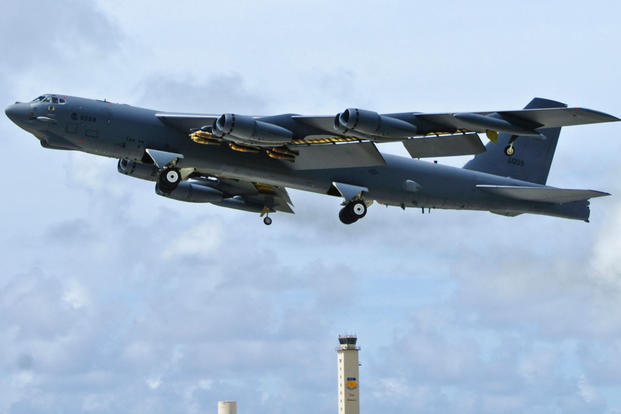The Air Force doesn't currently plan to put B-52 Stratofortress bombers on a 24-hour nuclear mission alert, a general said on Monday.
"There's not any discussions or plans to bring bombers on a 24-hour nuclear alert right now," Air Force spokesman Brig. Gen. Ed Thomas told reporters at the Pentagon during a briefing.
But it doesn't mean they couldn't.
When asked if the new and upgraded facilities could be used for such a mission, Thomas replied, "Absolutely they could be."
Related content:
- Air Force Preparing B-52 Bombers for 24-Hour Alert Status: Report
- START Lanced the B-1's Nukes, But the Bomber Will Still Get New Bombs
- Without New Nuclear Weapon, B-52 Bomber Mission Ends, General Warns
"Because frankly they are for the NC3 [nuclear command, control and communications] crews -- they will be used as alert facilities," he said.
The general's comments followed a report from DefenseOne that the Air Force is preparing to put the bombers back on 24-hour alert status in part by upgrading facilities for hundreds of airmen to support the potential mission.
Chief of Staff Gen. David Goldfein, the service's top uniformed leader, told a reporter during a recent trip to Barksdale Air Force Base, Louisiana, that preparations are underway should the Air Force get the call to reinstate the 24-hour alert status.
"This is yet one more step in ensuring that we're prepared," Goldfein said in the interview. "I look at it more as not planning for any specific event, but more for the reality of the global situation we find ourselves in and how we ensure we're prepared going forward," he said.
Goldfein's comments come at a time of rising tensions between the U.S. and North Korea, which continues to test ballistic missiles and nuclear warheads despite repeated condemnation from the international community.
During the briefing at the Pentagon on Monday, Thomas added, "We're routinely upgrading our facilities. Whether it's Barksdale or Offutt [Air Force Base, Nebraska] or other locations. [Civil engineers] are always able to take the limited tax dollars we have and be able to keep [facilities] in a high-state of readiness."
Until 1991, pilots sat on "strip alert," he said, in facilities near bombers should they need to take off at a moment's notice and conduct a nuclear strike anywhere in the world. That infrastructure is currently being renovated.
The general didn't say whether similar renovations are occurring at Minot Air Force Base in North Dakota or other installations where nuclear bombers also operate.
When asked if the Air Force is thus unprepared for the mission should they get the call, Thomas replied, "Options is our business. Those discussions aren't happening -- could they? Or would we be ready for them? Absolutely.
"We prepare for every contingency," he said, adding that STRATCOM would "own" such a decision.
"All decisions would come from U.S. Strategic Command" on how to best use B-52 Stratofortress or B-2 Spirit bombers "if we were to do it," Thomas said.
The B-52 or B-2 would be the only bomber platforms in the Air Force's inventory to execute a nuclear attack from an aircraft. The B-1B Lancer is no longer a nuclear-capable bomber.
He added, "Could we do the mission? We could stand that up very quickly."
Separately, AFGSC stood-up a new organization in April to oversee the Air Force's NC3 systems in an activation ceremony at Barksdale.
-- Oriana Pawlyk can be reached at oriana.pawlyk@military.com. Follow her on Twitter at @Oriana0214.
Related Video:
B-52 Stratofortress | Bullet Points
























